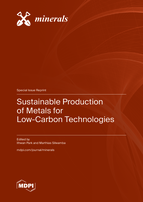Sustainable Production of Metals for Low-Carbon Technologies
A special issue of Minerals (ISSN 2075-163X). This special issue belongs to the section "Mineral Processing and Extractive Metallurgy".
Deadline for manuscript submissions: closed (26 August 2022) | Viewed by 41587
Special Issue Editors
Interests: mineral processing; flotation; hydrometallurgy; leaching; electrochemistry; recycling; environmental chemistry; acid mine drainage; sulfide passivation
Special Issues, Collections and Topics in MDPI journals
Special Issue Information
Dear Colleagues,
A high demand for metals (cobalt, copper, gold, lithium, nickel, tin, vanadium, etc.) has been recorded for the past several decades, and this demand is expected to increase even further in the coming decades as the world moves to low-carbon technologies based on renewable energy sources (RESs) and electric vehicles (EVs), and away from the heavy use of fossil fuels. To meet the high forecasted demand, unconventional sources of metals such as low-grade complex ores, seafloor massive sulfides (SMSs), and wastes (e.g., tailings, metallurgical residues, and electronic wastes (e-wastes)) have become very important sources of metals; moreover, these metals should be extracted in a sustainable manner without negatively impacting the environment.
This Special Issue will focus on recent advances in the sustainable production of metals from the abovementioned unconventional sources. Specifically, we will accept research papers, short-communications, and review papers on advancements made in sustainable beneficiation (i.e., gravity separation, magnetic separation, flotation, etc.), the extraction of metals (i.e., atmospheric leaching, bioleaching, pressure leaching, solvometallurgy), environmental remediation, waste management, and e-waste recycling.
Dr. Ilhwan Park
Dr. Marthias Silwamba
Guest Editors
Manuscript Submission Information
Manuscripts should be submitted online at www.mdpi.com by registering and logging in to this website. Once you are registered, click here to go to the submission form. Manuscripts can be submitted until the deadline. All submissions that pass pre-check are peer-reviewed. Accepted papers will be published continuously in the journal (as soon as accepted) and will be listed together on the special issue website. Research articles, review articles as well as short communications are invited. For planned papers, a title and short abstract (about 100 words) can be sent to the Editorial Office for announcement on this website.
Submitted manuscripts should not have been published previously, nor be under consideration for publication elsewhere (except conference proceedings papers). All manuscripts are thoroughly refereed through a single-blind peer-review process. A guide for authors and other relevant information for submission of manuscripts is available on the Instructions for Authors page. Minerals is an international peer-reviewed open access monthly journal published by MDPI.
Please visit the Instructions for Authors page before submitting a manuscript. The Article Processing Charge (APC) for publication in this open access journal is 2400 CHF (Swiss Francs). Submitted papers should be well formatted and use good English. Authors may use MDPI's English editing service prior to publication or during author revisions.
Keywords
- flotation
- gravity concentration
- magnetic separation
- solvometallurgy
- leaching
- hydrometallurgy
- environmental remediation
- waste management
- e-waste recycling
- low-carbon technologies







